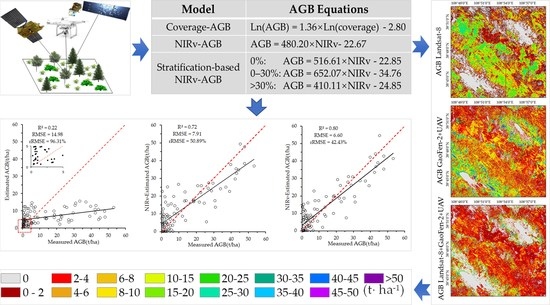Improving Estimation of Woody Aboveground Biomass of Sparse Mixed Forest over Dryland Ecosystem by Combining Landsat-8, GaoFen-2, and UAV Imagery
Abstract
:1. Introduction
2. Study Area and Data
2.1. Study Area
2.2. Data and Processing
3. Methodology
3.1. Overall Methodology
3.2. Calculation of the Plot-Level Woody AGB Using Woody Structural Parameters
3.3. Coverage Survey of the Woody and Herbaceous Vegetation Using UAV RGB Image
3.4. Development of Different Plot-Level Woody AGB Models Using Landsat-8 and UAV Imagery
3.5. Regional Simulation of Woody AGB Using Landsat-8 and GaoFen-2 Imagery
3.5.1. Calibration of Woody and Herbaceous Coverage Derived from the GaoFen-2 Image
3.5.2. Accuracy Assessment of Woody AGB Estimates Using Different Methods
4. Results and Analysis
4.1. Classification and Accuracy Assessment of UAV RGB Image
4.2. Plot-Level Woody AGB Models
4.3. Woody and Herbaceous Coverage Derived from GaoFen-2 Image
4.4. Accuracy Assessment of the Woody AGB Estimations Obtained Using Different Modeling Schemes
5. Discussion
5.1. Applicability of the Woody Cover-AGB Model to Sparse Mixed Forests
5.2. Applicability of the Landsat VI-AGB Model to Sparse Mixed Forest
5.3. Potential of Using High-Resolution Remote Sensing Images for AGB Estimation of Sparse Mixed Forest
5.4. Uncertainty Analysis
6. Conclusions
Author Contributions
Funding
Data Availability Statement
Acknowledgments
Conflicts of Interest
References
- Xiao, J.F.; Frederic, C.; Cecile, G.; Luis, G.; Jeffrey, A.H. Remote sensing of the terrestrial carbon cycle: A review of advances over 50 years. Remote Sens. Environ. 2019, 233, 1383. [Google Scholar] [CrossRef]
- Chen, J. Carbon neutrality: Toward a sustainable future. Innovation 2021, 2, 100127. [Google Scholar] [CrossRef] [PubMed]
- Smith, W.K.; Dannenberg, M.P.; Yan, D.; Herrmann, S.; Barnes, M.L.; Barron-Gafford, G.A. Remote sensing of dryland ecosystem structure and function: Progress, challenges, and opportunities. Remote Sens. Environ. 2019, 233, 1401. [Google Scholar] [CrossRef]
- Zhang, Y.; Peng, C.H.; Li, W.D.; Tian, L.X.; Zhu, Q.; Chen, H.; Fang, X.Q. Multiple afforestation programs accelerate the greenness in the ‘Three North’ region of China from 1982 to 2013. Ecol. Indic. 2016, 61, 404–412. [Google Scholar] [CrossRef]
- Liu, L.Y. Opportunities of Mapping Forest Carbon Stock and its Annual Increment Using Landsat Time-Series Data. Geoinformatics Geostat. Overv. 2016, 4, 151. [Google Scholar] [CrossRef] [Green Version]
- Guo, Z.; Wang, T.; Liu, S.L.; Kang, W.P.; Chen, X. Biomass and vegetation coverage survey in the Mu Us sandy land-based on unmanned aerial vehicle RGB images. Int. J. Appl. Earth Obs. Geoinf. 2021, 94, 2239. [Google Scholar] [CrossRef]
- Main-Knorn, M.; Cohen, W.B.; Kennedy, R.E.; Grodzki, W.; Pflugmacher, D. Monitoring coniferous forest biomass change using a Landsat trajectory-based approach. Remote Sens. Environ. 2013, 139, 277–290. [Google Scholar] [CrossRef]
- Liu, L.Y.; Peng, D.L.; Wang, Z.H. Improving artificial forest biomass estimates using afforestation age information from time series Landsat stacks. Environ. Monit. Assess. 2014, 186, 7293–7306. [Google Scholar] [CrossRef]
- Peng, D.L.; Zhang, H.L.; Liu, L.Y. Estimating the Aboveground Biomass for Planted Forests Based on Stand Age and Environmental Variables. Remote Sens. 2019, 11, 2270. [Google Scholar] [CrossRef] [Green Version]
- Ni, W.J.; Zhang, Z.Y.; Sun, G.Q.; Sun, Y.F.; He, Y.T. The Penetration Depth Derived from the Synthesis of ALOS/PALSAR InSAR Data and ASTER GDEM for the Mapping of Forest Biomass. Remote Sens. 2014, 6, 7307–7319. [Google Scholar] [CrossRef] [Green Version]
- Latifi, H.; Fassnacht, F.E.; Hartig, F.; Berger, C.; Hernández, J.; Corvalán, P. Stratified aboveground forest biomass estimation by remote sensing data. Int. J. Appl. Earth Obs. Geoinf. 2015, 38, 229–241. [Google Scholar] [CrossRef]
- Liu, X.; Yang, L.; Liu, Q.H.; Li, J. Review of forest above ground biomass inversion methods based on remote sensing technology. J. Remote Sens. 2015, 19, 62–74. (In Chinese) [Google Scholar]
- Lu, D.; Chen, G.; Wang, Q.; Liu, L.; Li, G.; Moran, E. A survey of remote sensing-based aboveground biomass estimation methods in forest ecosystems. Int. J. Digit. Earth 2016, 9, 63–105. [Google Scholar] [CrossRef]
- Markus, T.; Neumann, T.; Martino, A.; Abdalati, W.; Brunt, K.; Csatho, B.; Farrell, S. The Ice, Cloud, and land Elevation Satellite-2 (ICESat-2): Science requirements, concept, and implementation. Remote Sens. Env. 2017, 190, 260–273. [Google Scholar] [CrossRef]
- Le Toan, T.; Quegan, S.; Davidson, M.; Balzter, H.; Paillou, P.; Papathanassiou, K. The BIOMASS mission: Mapping global forest biomass to better understand the terrestrial carbon cycle. Remote Sens. Environ. 2011, 115, 2850–2860. [Google Scholar] [CrossRef] [Green Version]
- Rosen, P.; Hensley, S.; Shaffer, S.; Edelstein, W.; Kim, Y.; Kumar, R.; Misra, T. An update on the NASA-ISRO dual-frequency dbf SAR(NISAR) mission. In 2016 IEEE International Geoscience and Remote Sensing Symposium; IEEE: New York, NY, USA, 2016; pp. 2106–2108. [Google Scholar]
- Todd, S.W.; Hoffer, R.M.; Milchunas, D.G. Biomass estimation on grazed and ungrazed rangelands using spectral indices. Int. J. Remote Sens. 1998, 19, 427–438. [Google Scholar] [CrossRef]
- Boyd, D.S.; Foody, G.M.; Ripple, W.J. Evaluation of approaches for forest cover estimation in the Pacific Northwest, USA, using remote sensing. Appl. Geogr. 2002, 22, 375–392. [Google Scholar] [CrossRef]
- Zhang, L.; Wylie, B.; Loveland, T.; Fosnight, E.; Tieszen, L.L.; Ji, L.; Gilmanov, T. Evaluation and comparison of gross primary production estimates for the Northern Great Plains grasslands. Remote Sens. Environ. 2006, 106, 173–189. [Google Scholar] [CrossRef] [Green Version]
- Tan, K.; Piao, S.L.; Peng, C.H.; Fang, J.Y. Satellite-based estimation of biomass carbon stocks for northeast China’s forests between 1982 and 1999. Forest Ecol. Manag. 2006, 240, 114–121. [Google Scholar] [CrossRef]
- Yan, F.; Wu, B.; Wang, Y.J. Estimating spatiotemporal patterns of aboveground biomass using Landsat TM and MODIS images in the Mu Us Sandy Land, China. Agric. Forest Meteorol. 2015, 200, 119–128. [Google Scholar] [CrossRef]
- LI, F.; Zeng, Y.; Luo, J.H.; Ma, R.H.; Wu, B.F. Modeling grassland aboveground biomass using a pure vegetation index. Ecol. Indic. 2016, 62, 279–288. [Google Scholar] [CrossRef]
- Zhao, P.P.; Lu, D.S.; Wang, G.X.; Wu, C.P.; Huang, Y.J.; Yu, S.Q.; Tomppo, E.; McRorberts, B.E. Examining Spectral Reflectance Saturation in Landsat Imagery and Corresponding Solutions to Improve Forest Aboveground Biomass Estimation. Remote Sens. 2016, 8, 469. [Google Scholar] [CrossRef] [Green Version]
- Rahman, S.L.; Nichol, J.E. Improved forest biomass estimates using ALOS AVNIR-2 texture indices. Remote Sens. Environ. 2010, 115, 968–977. [Google Scholar]
- Shoshany, M.; Karnibad, L. Mapping shrubland biomass along Mediterranean climatic gradients: The synergy of rainfall-based and NDVI-based models. Int. J. Remote Sens. 2011, 32, 9497–9508. [Google Scholar] [CrossRef]
- Chen, Q.; Vaglio, L.G.; Battles, J.J.; Saah, D. Integration of airborne lidar and vegetation types derived from aerial photography for mapping aboveground live biomass. Remote Sens. Environ. 2012, 121, 108–117. [Google Scholar] [CrossRef]
- Feng, Y.Y.; Lu, D.S.; Chen, Q.; Keller, M.; Moran, E.; Nara, D.S.; Luis, B.E.; Batistella, M. Examining Effective Use of Data Sources and Modeling Algorithms for Improving Biomass Estimation in a Moist Tropical Forest of the Brazilian Amazon; Taylor & Francis: Oxfordshire, UK, 2017; Volume 10, pp. 996–1016. [Google Scholar]
- Jiang, X.D.; Li, G.Y.; Lu, D.S.; Chen, E.X.; Wei, X.L. Stratification-Based Forest Aboveground Biomass Estimation in a Subtropical Region Using Airborne Lidar Data. Remote Sens. 2020, 12, 1101. [Google Scholar] [CrossRef] [Green Version]
- Zandler, H.; Brenning, A.; Samimi, B. Quantifying dwarf shrub biomass in an arid environment: Comparing empirical methods in a high dimensional setting. Remote Sens. Environ. 2015, 158, 140–155. [Google Scholar] [CrossRef]
- Wang, Z.H.; Gary, N.B.; Liu, L.Y.; Peter, A.C.; Peng, D.L. Estimating woody above-ground biomass in an arid zone of central Australia using Landsat imagery. J. Appl. Remote Sens. 2015, 9, 096036. [Google Scholar] [CrossRef]
- Fu, T.; Pang, Y.; Huang, Q.N. Prediction of subtropical forest parameters using airborne laser scanner. Natl. Remote Sens. Bull. 2011, 15, 1092–1104. (In Chinese) [Google Scholar]
- Wang, Z.H.; Liu, L.Y.; Peng, D.L.; Liu, X.J.; Zhang, S. Estimating woody aboveground biomass in an area of agroforestry using airborne light detection and ranging and compact airborne spectrographic imager hyperspectral data: Individual tree analysis incorporating tree species information. J. Appl. Remote Sens. 2016, 10, 036007. [Google Scholar] [CrossRef]
- Lato, M.; Dong, P.; Chen, Q. LiDAR Remote Sensing and Applications. Math. Geosci. 2019, 51, 1874–8961. [Google Scholar]
- Leboeuf, A.; Beaudoin, A.; Fournier, R.A.; Guindon, L.; Luther, J.E.; Lambert, M.C. A shadow fraction method for mapping biomass of northern boreal black spruce forests using QuickBird imagery. Remote Sens. Environ. 2007, 110, 488–500. [Google Scholar] [CrossRef]
- Dube, T.; Gara, T.W.; Mutanga, O. Estimating forest standing biomass in savanna woodlands as an indicator of forest productivity using the new generation WorldView-2 sensor. Geocarto Int. 2018, 33, 178–188. [Google Scholar] [CrossRef]
- Maack, J.; Kattenborn, T.; Fassnacht, F.E.; Enßle, F.; Hernández, J. Modeling forest biomass using Very-High-Resolution data—Combining textural, spectral and photogrammetric predictors derived from spaceborne stereo images. Eur. J. Remote Sens. 2015, 48, 245–261. [Google Scholar] [CrossRef] [Green Version]
- Suganuma, H.; Abe, Y. Taniguchi, M.; Utsugi, H.; Kojima, T.; Yamada, K. Stand biomass estimation method by canopy coverage for application to remote sensing in an arid area of Western Australia. Forest Ecol. Manag. 2005, 222, 75–87. [Google Scholar] [CrossRef]
- Ozdemir, I. Estimating stem volume by tree crown area and tree shadow area extracted from pan-sharpened Quickbird imagery in open Crimean juniper forests. Int. J. Remote Sens. 2008, 29, 5643–5655. [Google Scholar] [CrossRef]
- Santoro, M.; Cartus, O.; Mermoz, S.; Bouvet, A.; Le Toan, T.; Carvalhais, N. A detailed portrait of the forest aboveground biomass pool for the year 2010 obtained from multiple remote sensing observations. Geophys. Res. Abstr. 2018, 20, 18932. [Google Scholar]
- Zhao, A.Z.; Zhang, A.B.; Lu, C.Y.; Wang, D.L.; Wang, H.F.; Liu, H.X. Spatiotemporal variation of vegetation coverage before and after implementation of Grain for Green Program in Loess Plateau, China. Ecol. Eng. 2017, 104, 13–22. [Google Scholar] [CrossRef]
- Liu, Z.J.; Liu, Y.S.; Li, Y.R. Anthropogenic contributions dominate trends of vegetation cover change over the farming-pastoral ecotone of northern China. Ecol. Indic. 2018, 95, 370–378. [Google Scholar] [CrossRef]
- Guo, Z.C.; Liu, S.L.; Kang, W.P.; Chen, X.Z.; Xue, Q. Change trend of vegetation coverage in the mu us sandy region from 2000 to 2015. Desert Res. 2018, 21, 19–37. (In Chinese) [Google Scholar]
- Li, H.K. Estimation and Evaluation of Forest Biomass Carbon Storage in China; China Forestry Press: Beijing, China, 2010; Volume 5, pp. 52–59. (In Chinese) [Google Scholar]
- Harikumar, A.; Bovolo, F.; Bruzzone, L. An internal crown geometric model for conifer species classification with high-density lidar data. IEEE Trans. Geosci. Remote Sens. 2017, 55, 2924–2940. [Google Scholar] [CrossRef]
- Chen, C.; Fu, J.Q.; Zhang, S.; Zhao, X. Coastline information extraction based on the tasseled cap transformation of Landsat-8 OLI images. Estuar. Coast. Shelf Sci. 2019, 217, 281–291. [Google Scholar] [CrossRef]
- Gilmore, P.R.; Millones, M. Death to Kappa: Birth of quantity disagreement and allocation disagreement for accuracy assessment. Int. J. Remote Sens. 2011, 32, 4407–4429. [Google Scholar]
- Eisfelder, C.; Kuenzer, C.; Dech, S. Derivation of biomass information for semi-arid areas using remote-sensing data. Int. J. Remote Sens. 2012, 33, 2937–2984. [Google Scholar] [CrossRef]
- Zhang, C.; Lu, D.S.; Chen, X.; Zhang, Y.M.; Maisupova, B.; Tao, Y. The spatiotemporal patterns of vegetation coverage and biomass of the temperate deserts in Central Asia and their relationships with climate controls. Remote Sens. Environ. 2016, 175, 271–281. [Google Scholar] [CrossRef]
- He, L.; Li, A.N.; Yin, G.F.; Nan, X.; Bian, J.H. Retrieval of Grassland Aboveground Biomass through Inversion of the PROSAIL Model with MODIS Imagery. Remote Sens. 2019, 11, 1597. [Google Scholar] [CrossRef] [Green Version]
- Zhang, X.Y.; Kondragunta, S. Estimating forest biomass in the USA using generalized allometric models and MODIS land products. Geophys. Res. Lett. 2006, 33, L09402. [Google Scholar] [CrossRef] [Green Version]
- Luo, Y.P.; El-Madany, T.S.; Filippa, G.; Ma, X.L.; Ahrens, B.; Carrara, A. Using Near-Infrared-Enabled Digital Repeat Photography to Track Structural and Physiological Phenology in Mediterranean Tree–Grass Ecosystems. Remote Sens. 2018, 10, 1293. [Google Scholar] [CrossRef] [Green Version]
- Fernández-Martínez, M.; John, G.; Hmimina, G.; Filella, L.; Balzarolo, M.; Benjamin, S. Monitoring Spatial and Temporal Variabilities of Gross Primary Production Using Maiac Modis Data. Remote Sens. 2019, 11, 874. [Google Scholar] [CrossRef] [Green Version]
- Huang, X.J.; Xiao, J.F.; Ma, M.G. Evaluating the Performance of Satellite-Derived Vegetation Indices for Estimating Gross Primary Productivity Using FLUXNET Observations across the Globe. Remote Sens. 2019, 11, 1823. [Google Scholar] [CrossRef] [Green Version]
- Hinojo-Hinojo, C.; Michael, L.G. Plant Traits Help Explain the Tight Relationship between Vegetation Indices and Gross Primary Production. Remote Sens. 2020, 12, 1405. [Google Scholar] [CrossRef]
- Grayson, B.; Christopher, B.F.; Joseph, A.B. Canopy near-infrared reflectance and terrestrial photosynthesis. Sci. Adv. 2017, 3, e1602244. [Google Scholar]
- Badgley, G.; Anderegg, L.; Berry, J.A. Terrestrial gross primary production: Using NIRV to scale from site to globe. Glob. Chang. Biol. 2019, 25, 3731–3740. [Google Scholar] [CrossRef] [PubMed]
- Wang, H.; Han, D.; Mu, Y. Landscape-level vegetation classification and fractional woody and herbaceous vegetation cover estimation over the dryland ecosystems by unmanned aerial vehicle platform. Agric. For. Meteorol. 2019, 278, 107665. [Google Scholar] [CrossRef]
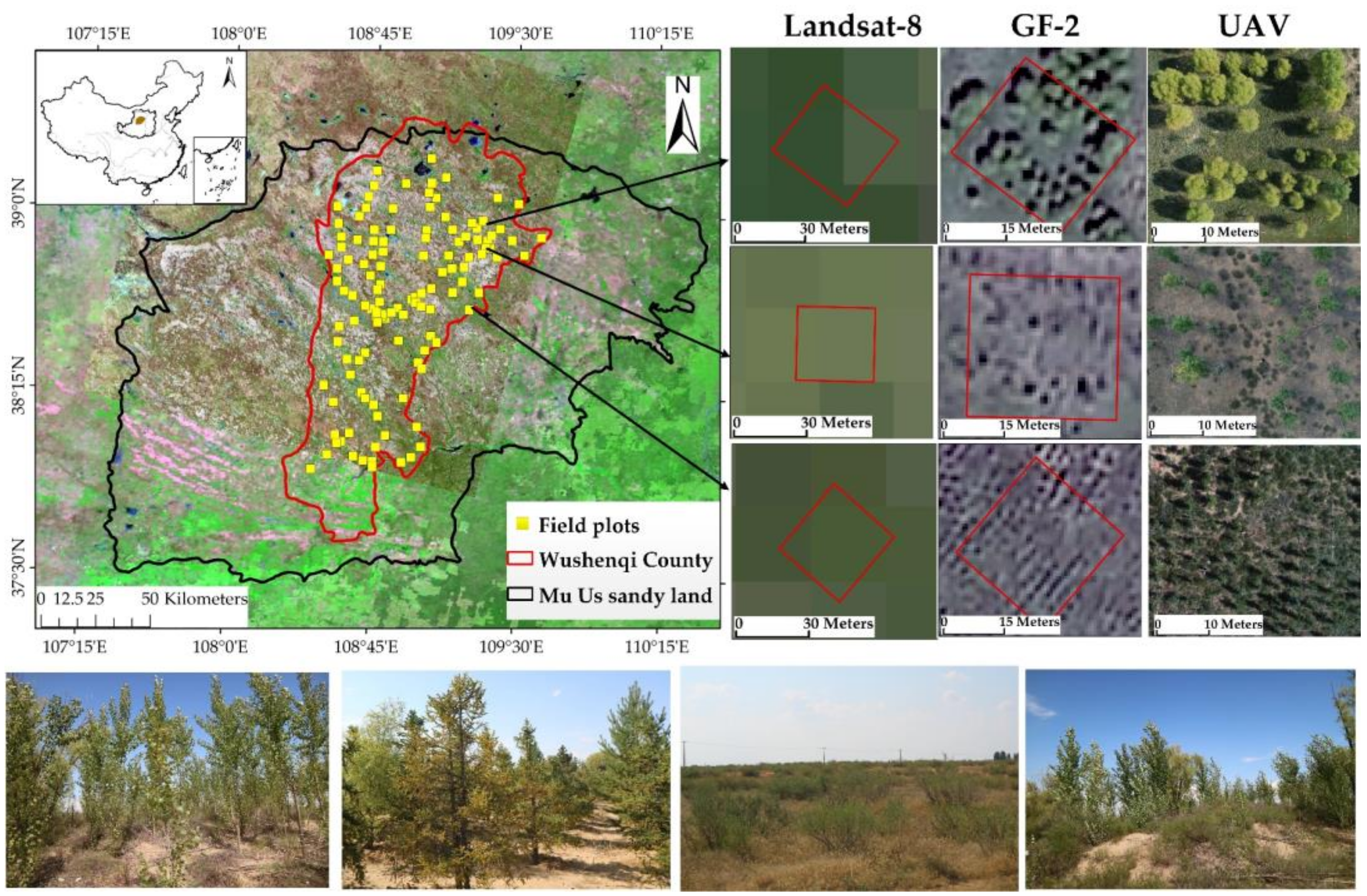
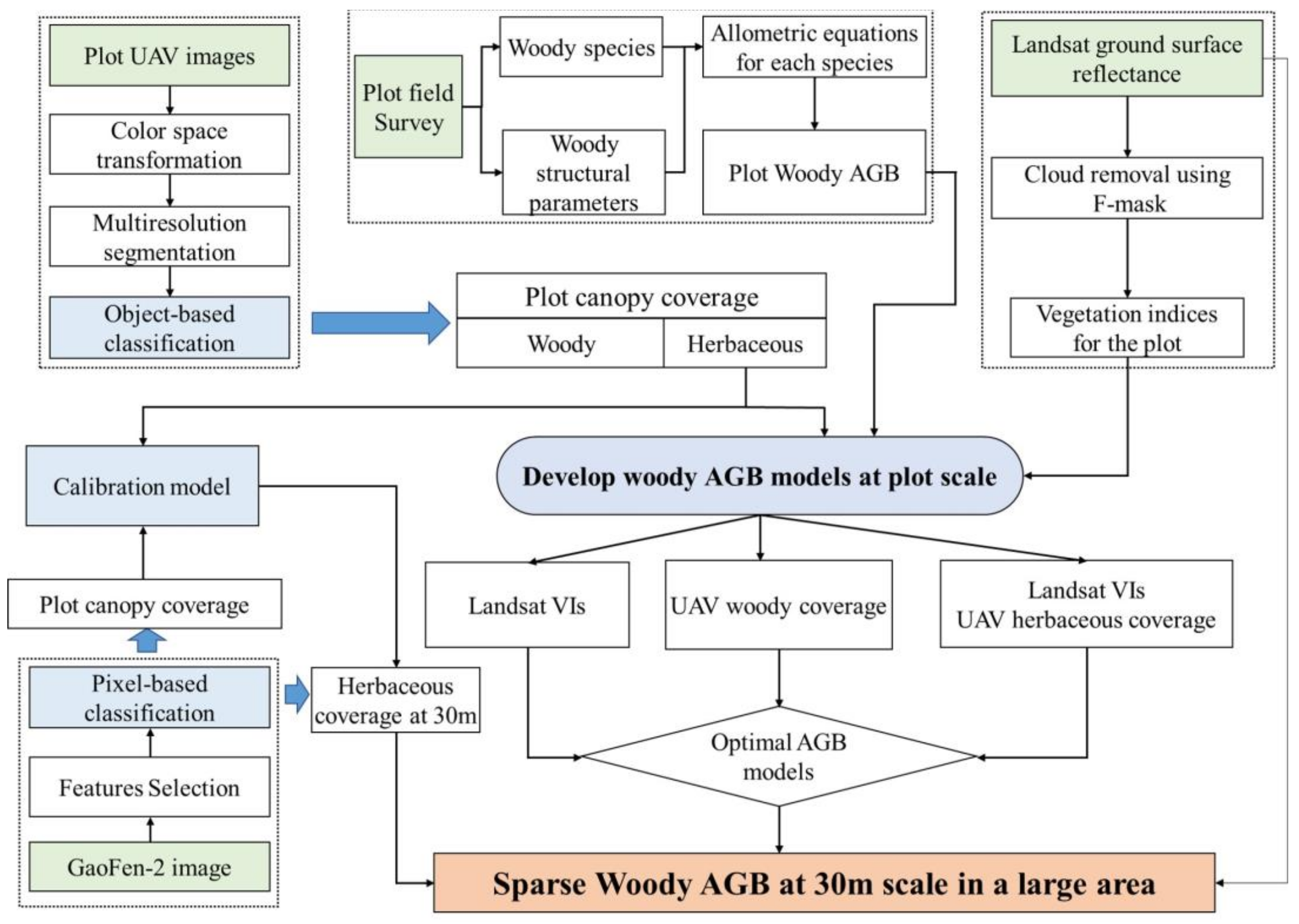
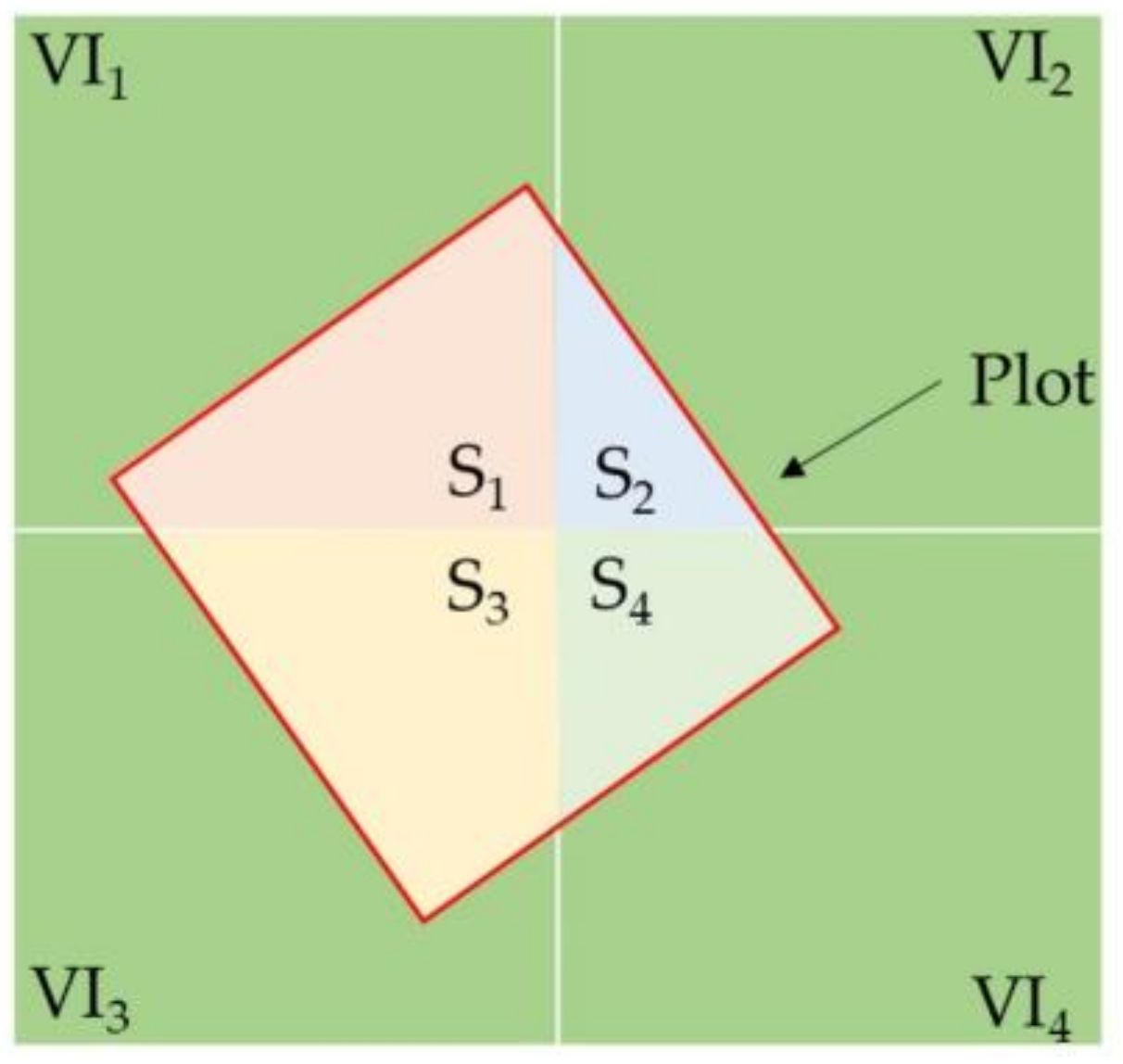
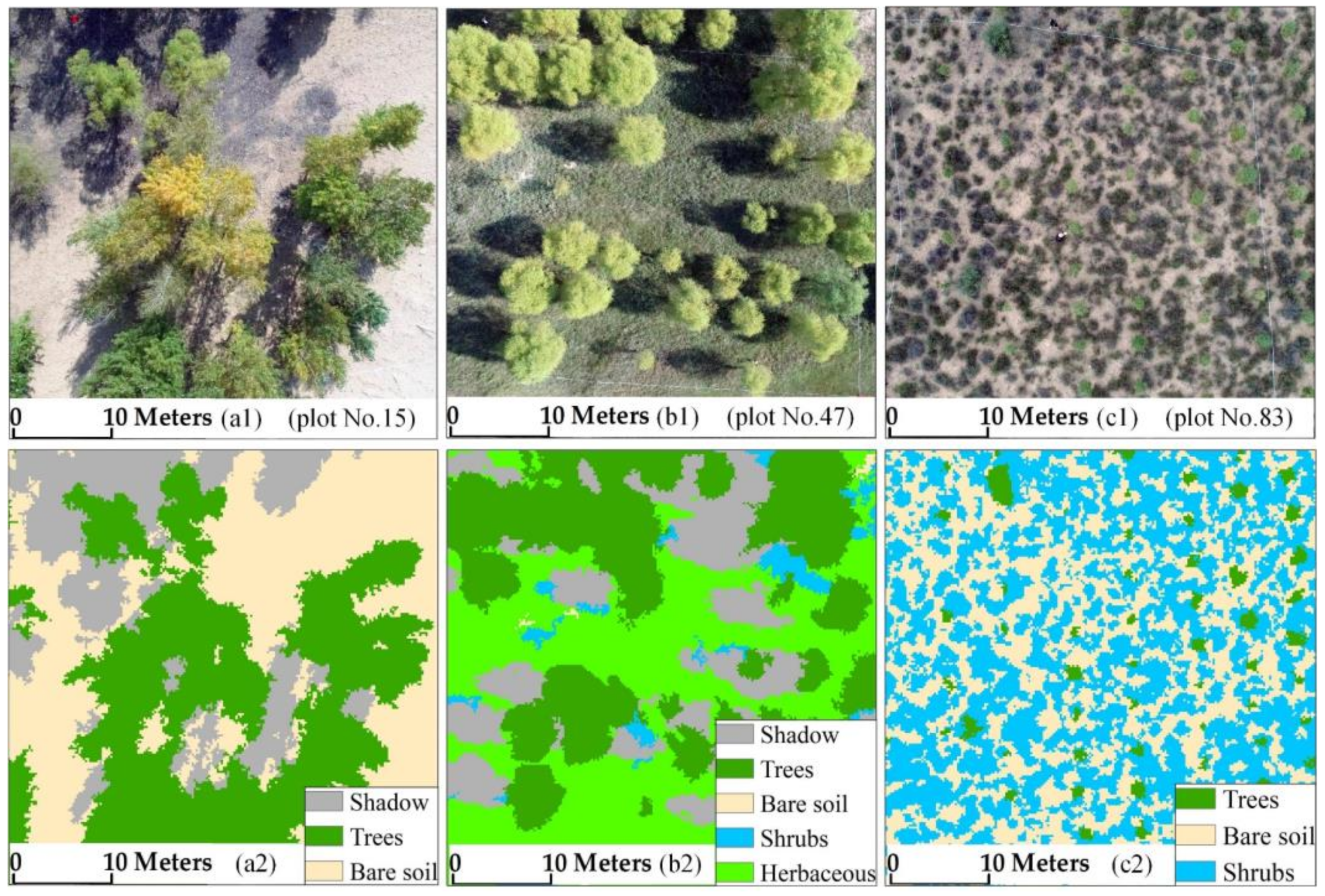
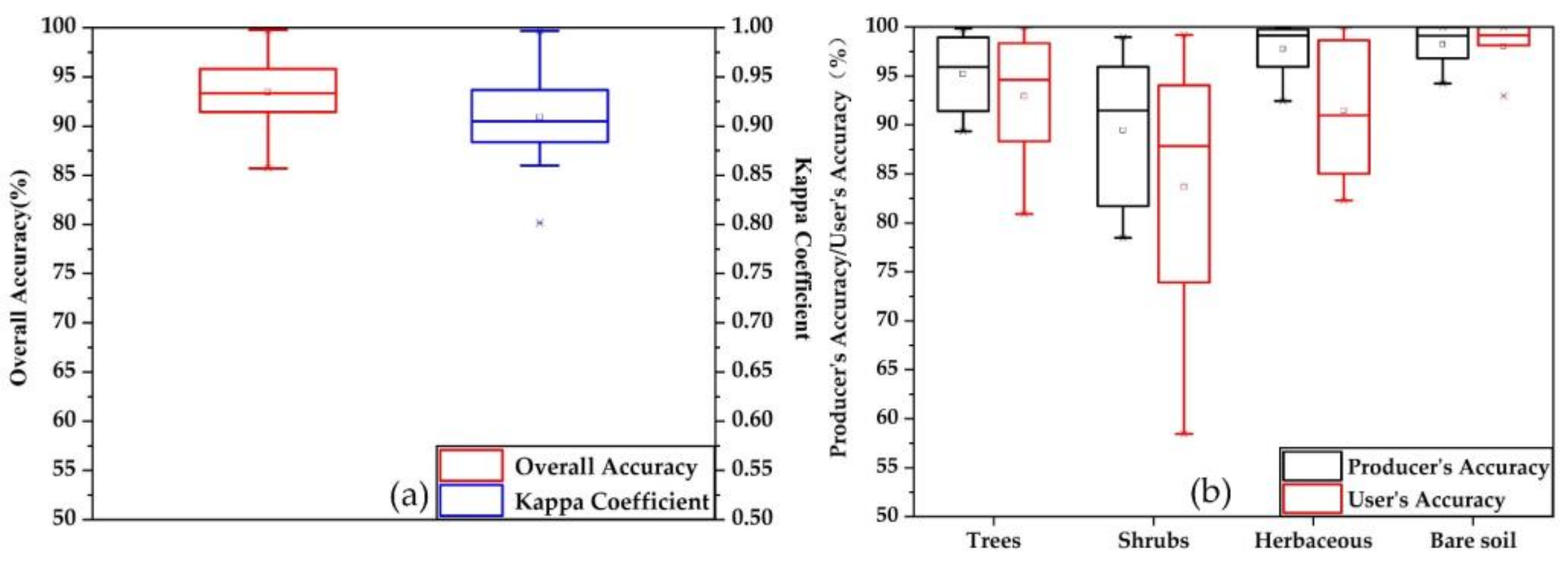

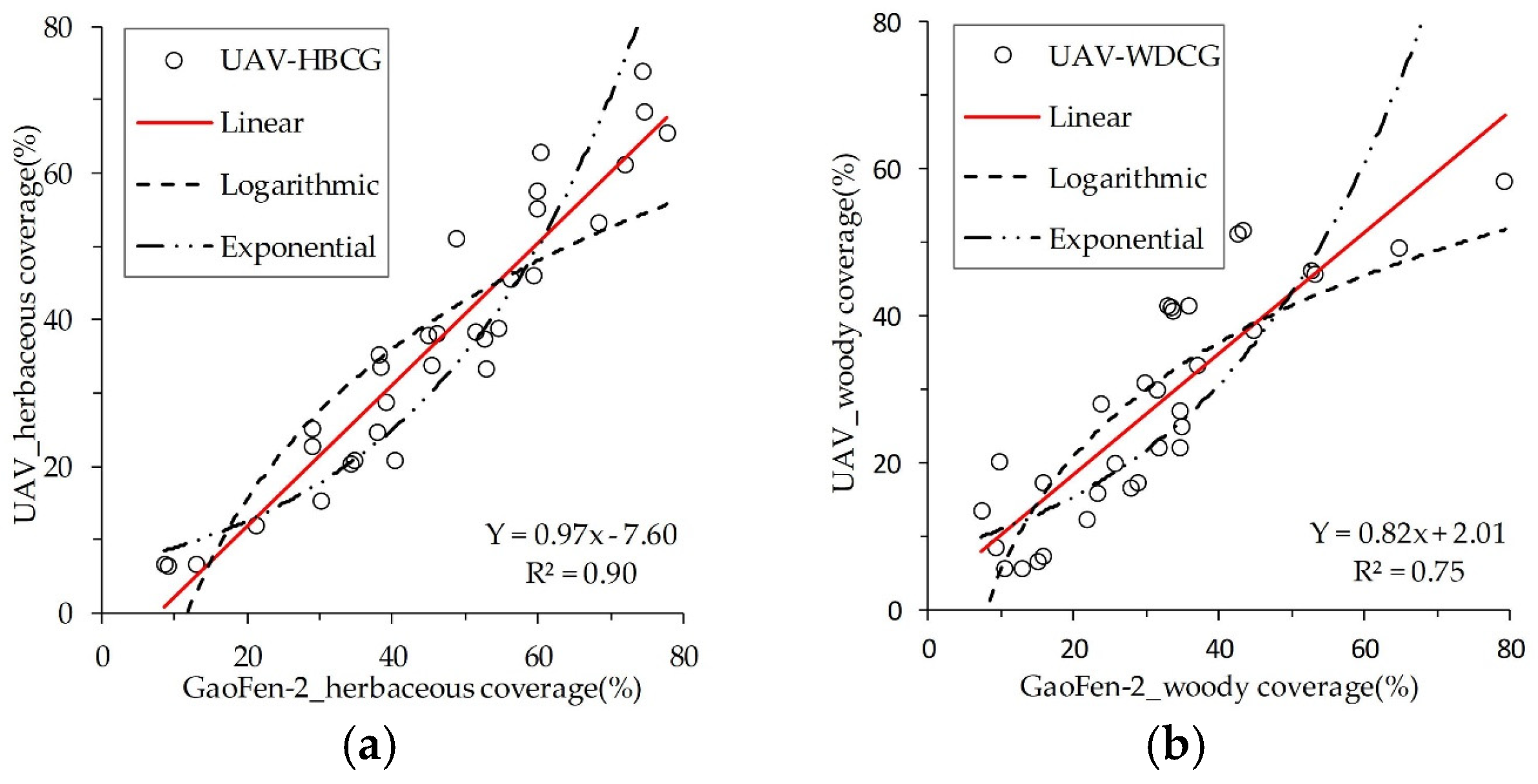
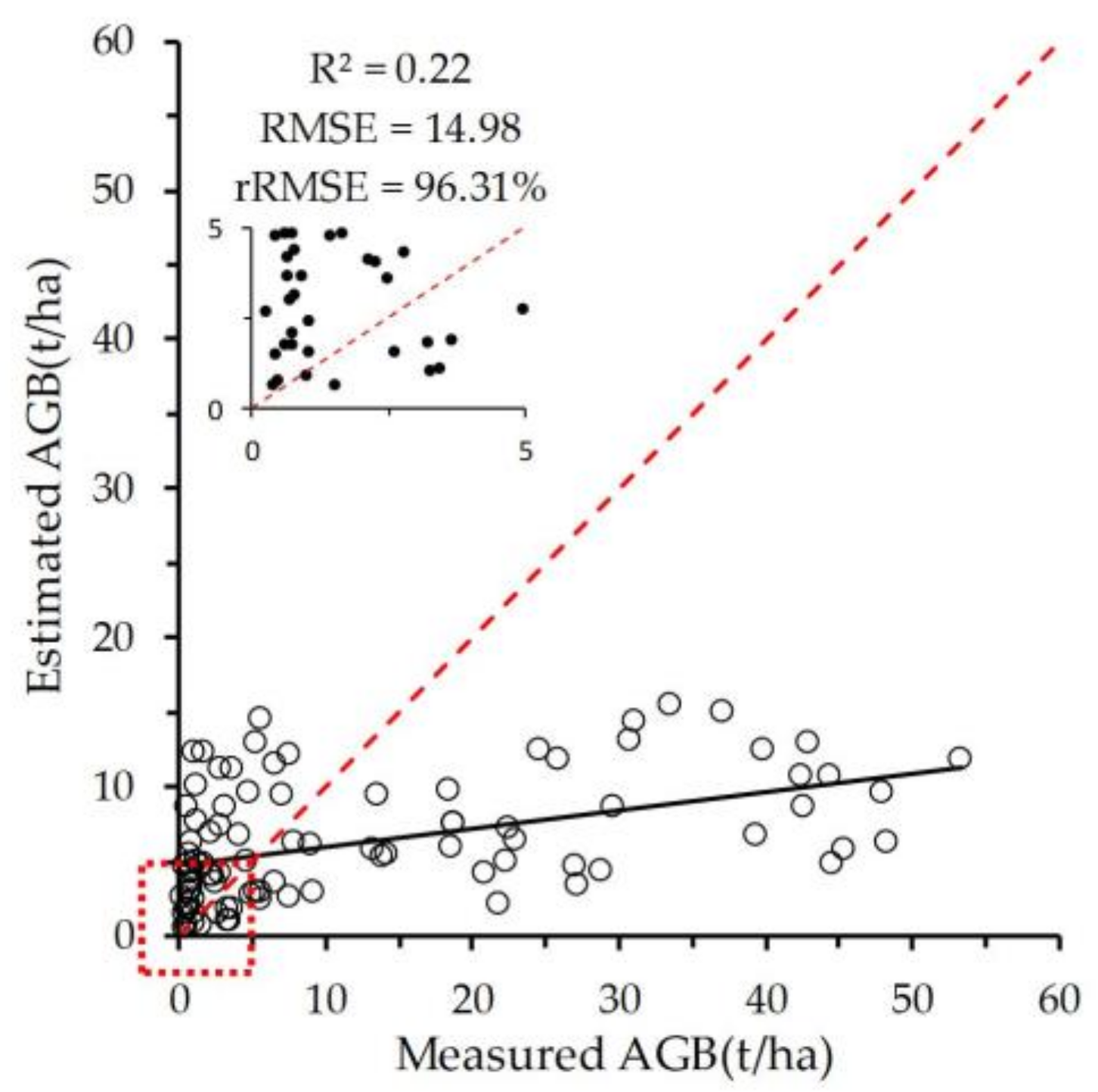
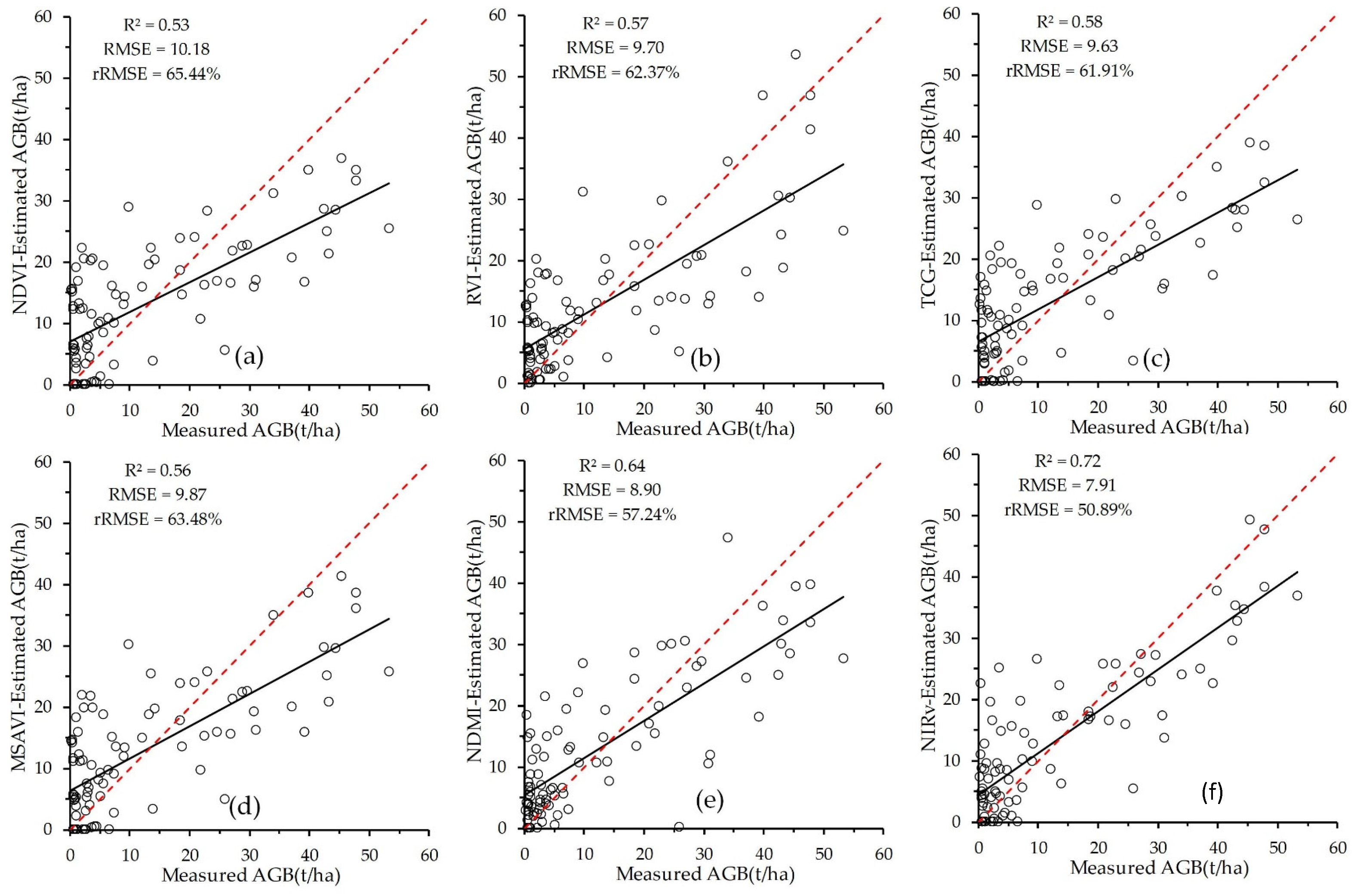
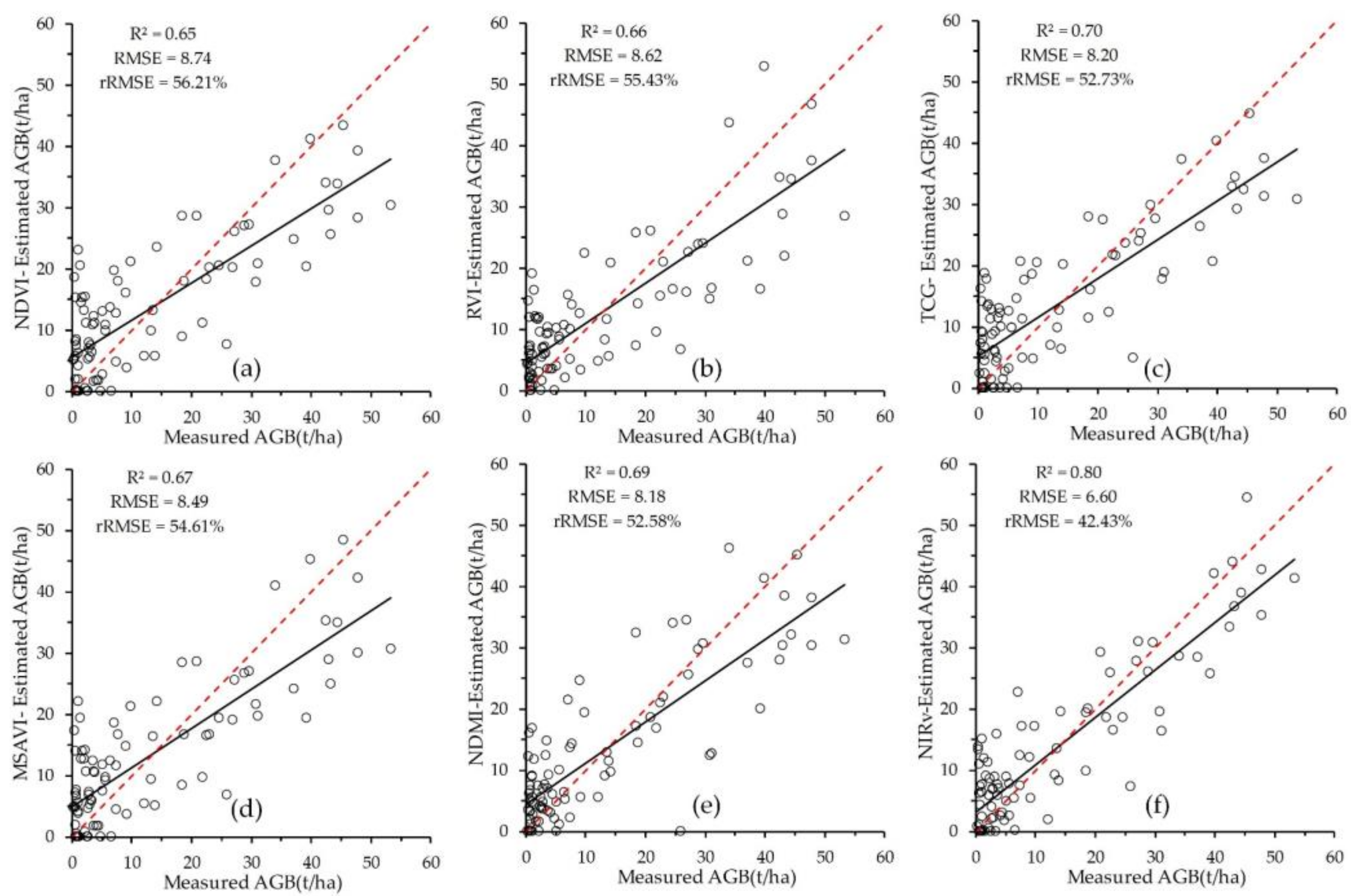
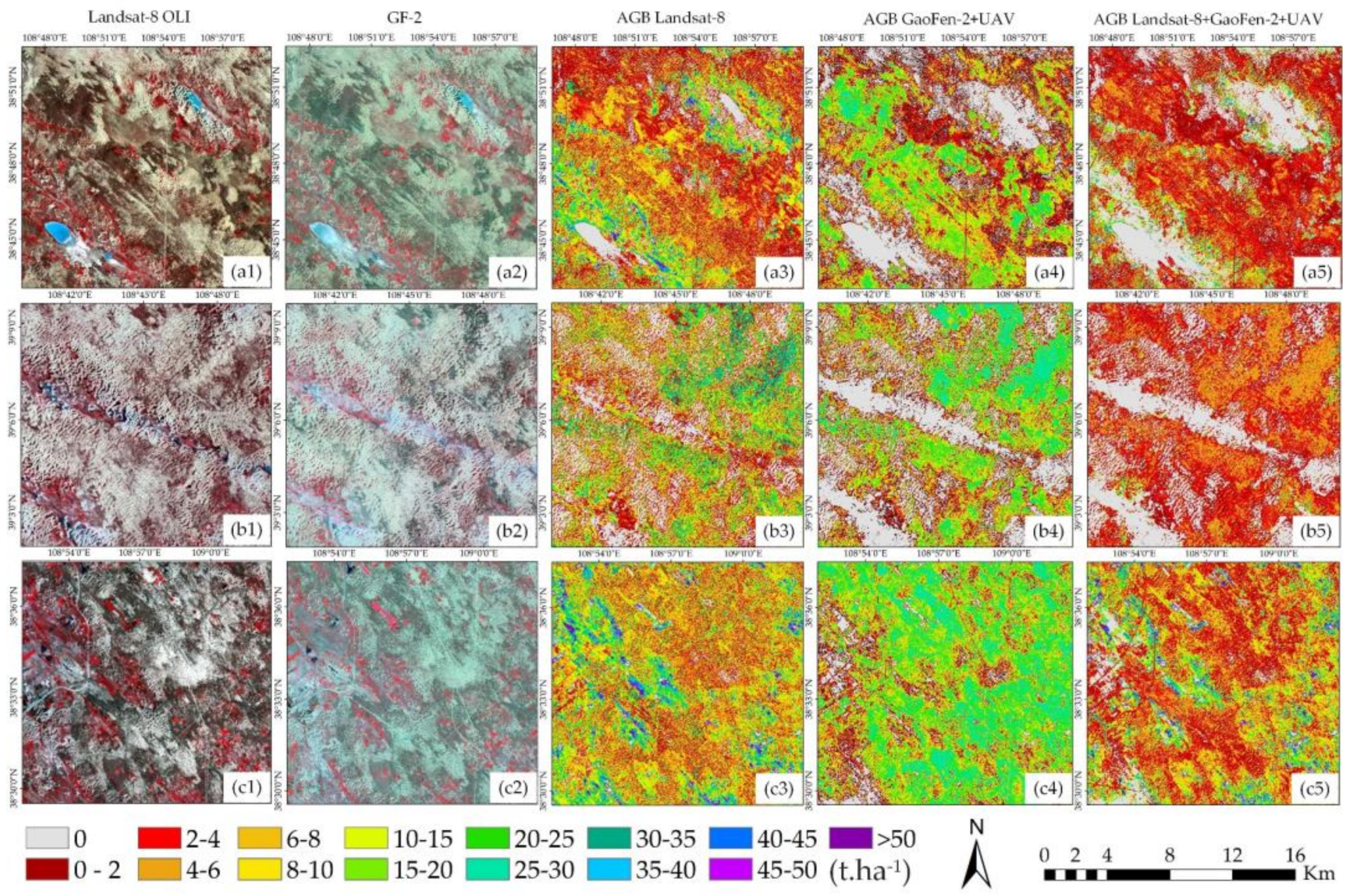
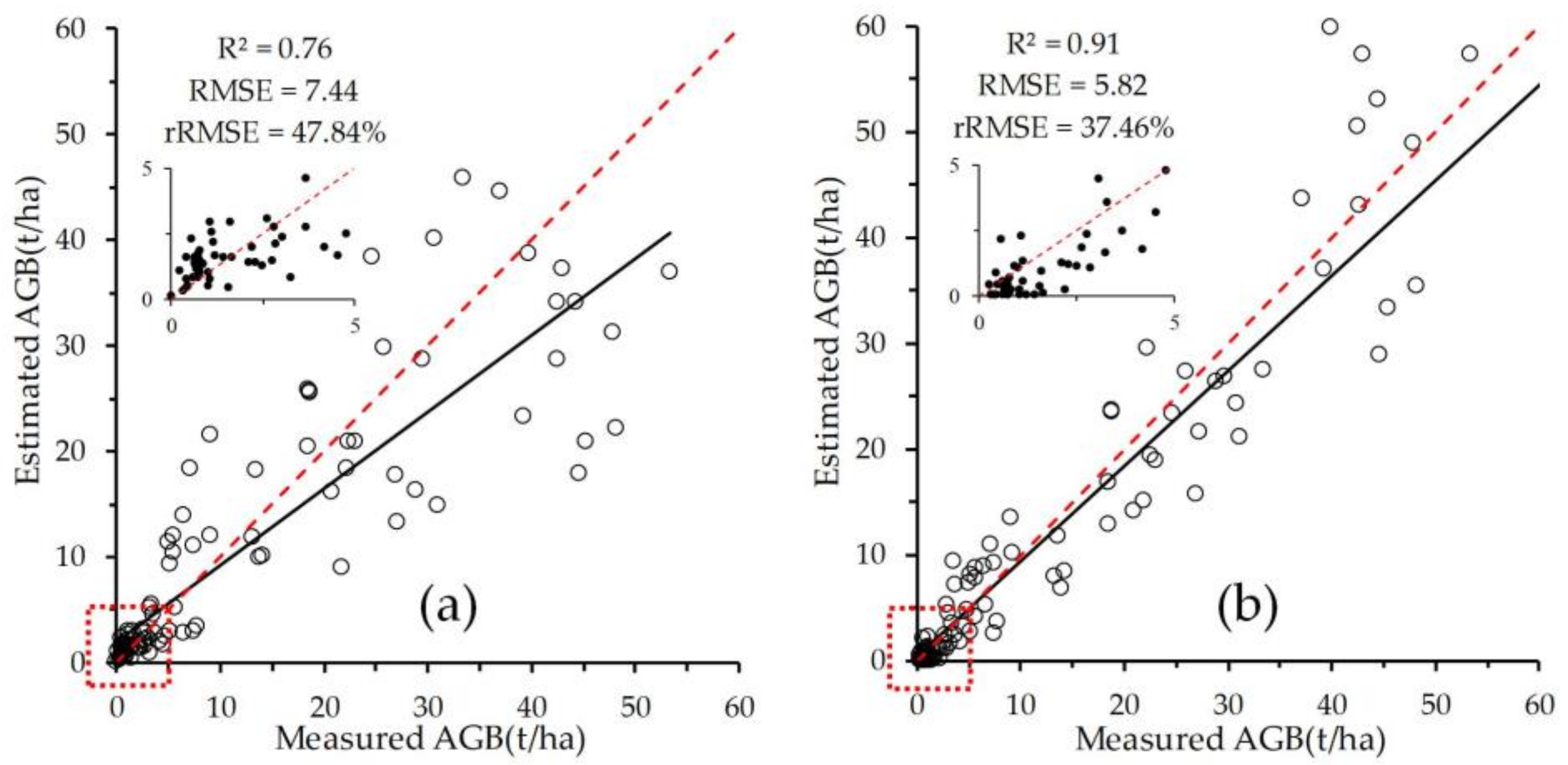
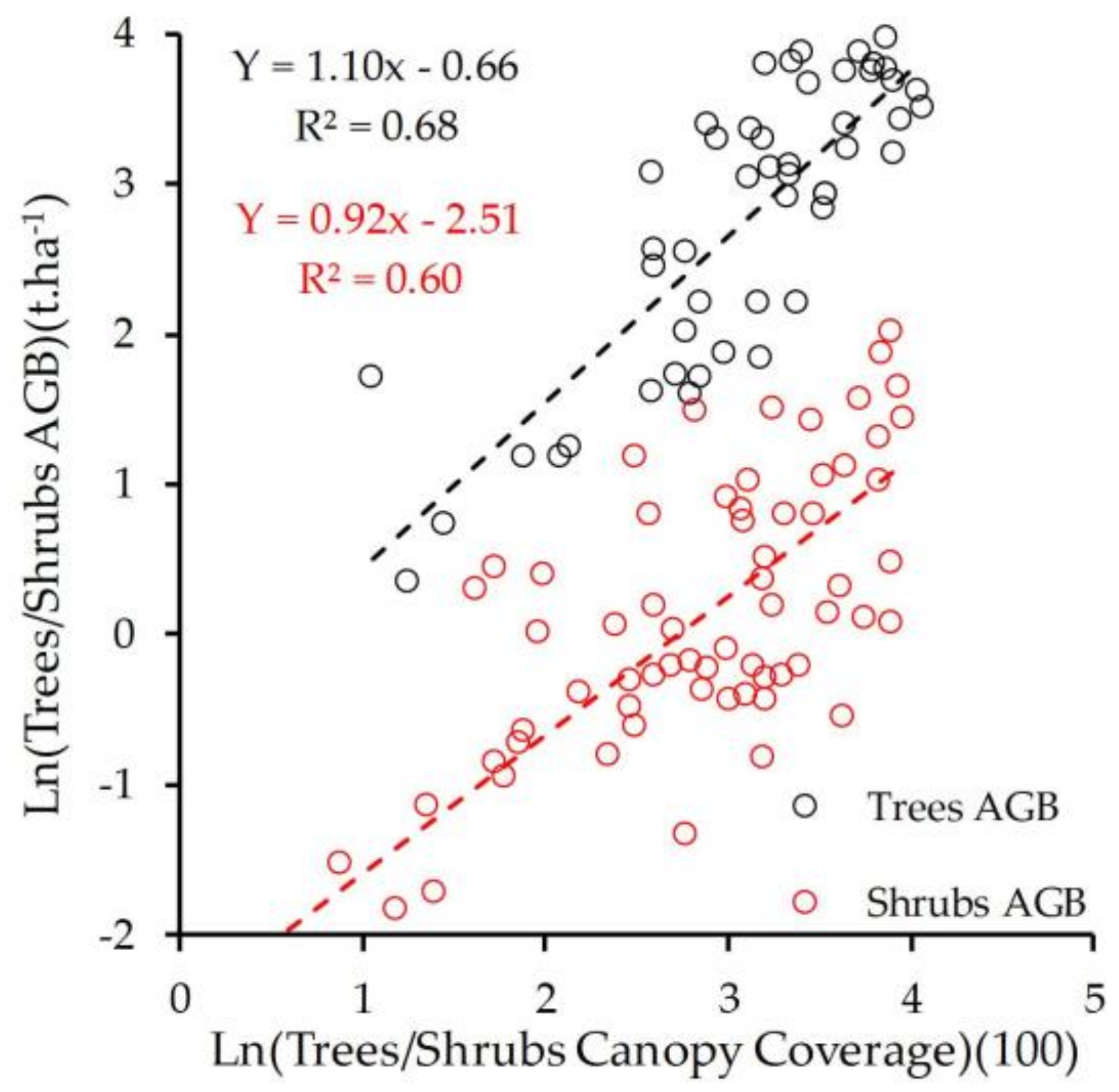
| Species | AGB Allometric Equations | Fit Figures (R2) | Reference |
|---|---|---|---|
| Populus alba L. | AGB = 0.306DBH1.886 | 0.98 | Liu et al. [8] |
| Salix matsudana | AGB = 0.0496 (DBH2 × H)0.952453 | 0.93 | Li et al. [43] |
| Pinus tabuliformis | AGB = 0.149DBH2.067 | 0.96 | Liu et al. [8] |
| Artemisia ordosida | AGB = 0.279Dc2.991 | 0.81 | Guo et al. [6] |
| Caragana korshinskii | AGB = 0.337Dc2.785 | 0.90 | Guo et al. [6] |
| Structural Parameters | N | Minimum (t∙ha−1) | Maximum (t∙ha−1) | Mean (t∙ha−1) | S.D. (t∙ha−1) | Range (t∙ha−1) | C.V. (%) |
|---|---|---|---|---|---|---|---|
| AGB | 102 | 0.26 | 53.36 | 15.55 | 14.85 | 53.10 | 95.52 |
| VI | Functions | Models | R2 |
|---|---|---|---|
| NDVI | Linear | Y = 97.735x − 18.003 | 0.51 |
| Logarithmic | Y = 27.373Ln(x) + 46.173 | 0.44 | |
| Exponential | Y = 0.3184e8.8939x | 0.44 | |
| Power | Y = 128.54x2.6217 | 0.41 | |
| TCG | Linear | Y = 0.0276x + 19.053 | 0.55 |
| Exponential | Y = 9.4216e0.0026x | 0.48 | |
| MSAVI | Linear | Y = 83.160x − 25.995 | 0.54 |
| Logarithmic | Y = 34.306Ln(x) + 40.288 | 0.47 | |
| Exponential | Y = 0.1436e7.7172x | 0.45 | |
| Power | Y = 74.613x3.3101 | 0.43 | |
| RVI | Linear | Y = 97.735x − 18.003 | 0.51 |
| Logarithmic | Y = 27.373Ln(x) + 46.173 | 0.44 | |
| Exponential | Y = 0.3184e8.8939x | 0.44 | |
| Power | Y = 128.54x2.6217 | 0.41 | |
| NDMI | Linear | Y = 149.93x + 20.082 | 0.64 |
| Exponential | Y = 10.229e13.72x | 0.54 | |
| NIRv | Linear | Y = 480.20x − 22.667 | 0.70 |
| Logarithmic | Y = 33.89Ln(x) + 103.10 | 0.61 | |
| Exponential | Y = 0.2298e42.357x | 0.55 | |
| Power | Y = 23824x3.1599 | 0.54 |
| VI | Functions | Models | R2 |
|---|---|---|---|
| NDVI | Linear | 0%: Y = 111.54x − 19.293 | 0.65 |
| 0–30%: Y = 121.40x − 24.702 | 0.64 | ||
| >30%: Y = 102.32x − 29.124 | 0.50 | ||
| Logarithmic | 0%: Y = 31.223Ln(x) + 54.089 | 0.58 | |
| 0–30%: Y = 37.142Ln(x) + 58.097 | 0.59 | ||
| >30%: Y = 35.365Ln(x) + 44.720 | 0.43 | ||
| Exponential | 0%: Y = 0.3061e9.6566x | 0.54 | |
| 0–30%: Y = 0.2017e10.897x | 0.58 | ||
| >30%: Y = 0.0746e10.824x | 0.38 | ||
| Power | 0%: Y = 213.08x2.8507 | 0.53 | |
| 0–30%: Y = 366.90x3.3950 | 0.54 | ||
| >30%: Y = 237.71x3.9979 | 0.36 | ||
| TCG | Linear | 0%: Y = 0.0308x + 22.505 | 0.66 |
| 0–30%: Y = 0.0356x + 23.009 | 0.73 | ||
| >30%: Y = 0.0308x + 9.6486 | 0.6 | ||
| Exponential | 0%: Y = 11.698e0.0027x | 0.57 | |
| 0–30%: Y = 14.521e0.0032x | 0.62 | ||
| >30%: Y = 4.5089e0.0034x | 0.46 | ||
| MSAVI | Linear | 0%: Y = 94.951x − 28.409 | 0.67 |
| 0–30%: Y = 107.71x − 36.386 | 0.48 | ||
| >30%: Y = 98.414x − 43.915 | 0.51 | ||
| Logarithmic | 0%: Y = 39.091Ln(x) + 47.269 | 0.60 | |
| 0–30%: Y = 47.018Ln(x) + 50.882 | 0.43 | ||
| >30%: Y = 49.665Ln(x) + 40.409 | 0.42 | ||
| Exponential | 0%: Y = 0.1299e8.3746x | 0.54 | |
| 0–30%: Y = 0.0641e9.8794x | 0.59 | ||
| >30%: Y = 0.0137e10.652x | 0.37 | ||
| Power | 0%: Y = 116.45x3.5903 | 0.54 | |
| 0–30%: Y = 202.77x4.3808 | 0.56 | ||
| >30%: Y = 148.00x5.6361 | 0.35 | ||
| RVI | Linear | 0%: Y = 21.533x − 27.986 | 0.66 |
| 0–30%: Y = 24.120x − 33.575 | 0.63 | ||
| >30%: Y = 18.921x − 33.453 | 0.66 | ||
| Logarithmic | 0%: Y = 48.286Ln(x) − 16.241 | 0.68 | |
| 0–30%: Y = 53.155Ln(x) − 20.722 | 0.65 | ||
| >30%: Y = 44.899Ln(x) − 26.427 | 0.58 | ||
| Exponential | 0%: Y = 0.1728e1.7699x | 0.48 | |
| 0–30%: Y = 0.0971e2.1312x | 0.52 | ||
| >30%: Y = 0.0772e1.7848x | 0.38 | ||
| Power | 0%: Y = 0.4155X4.1127 | 0.53 | |
| 0–30%: Y = 0.2856X4.7860 | 0.56 | ||
| >30%: Y = 0.1175X4.5383 | 0.38 | ||
| NDMI | Linear | 0%: Y = 169.41x + 22.313 | 0.69 |
| 0–30%: Y = 132.19x + 21.200 | 0.69 | ||
| >30%: Y = 122.47x + 13.608 | 0.61 | ||
| Exponential | 0%: Y = 11.379e14.924x | 0.58 | |
| 0–30%: Y = 11.955e11.234x | 0.53 | ||
| >30%: Y = 7.0773e13.932x | 0.51 | ||
| NIRv | Linear | 0%: Y = 516.61x − 22.848 | 0.81 |
| 0–30%: Y = 652.07x − 34.755 | 0.86 | ||
| >30%: Y = 410.11x − 24.852 | 0.58 | ||
| Logarithmic | 0%: Y = 36.626Ln(x) + 113.29 | 0.74 | |
| 0–30%: Y = 48.360Ln(x) + 141.10 | 0.82 | ||
| >30%: Y = 32.952Ln(x) + 92.167 | 0.48 | ||
| Exponential | 0%: Y = 0.2340e44.163x | 0.64 | |
| 0–30%: Y = 0.0782e59.139x | 0.76 | ||
| >30%: Y = 0.1813e38.178x | 0.32 | ||
| Power | 0%: Y = 39917x3.2810 | 0.64 | |
| 0–30%: Y = 947913x4.5225 | 0.76 | ||
| >30%: Y = 24557x3.4355 | 0.33 |
Publisher’s Note: MDPI stays neutral with regard to jurisdictional claims in published maps and institutional affiliations. |
© 2021 by the authors. Licensee MDPI, Basel, Switzerland. This article is an open access article distributed under the terms and conditions of the Creative Commons Attribution (CC BY) license (https://creativecommons.org/licenses/by/4.0/).
Share and Cite
Shi, Y.; Wang, Z.; Liu, L.; Li, C.; Peng, D.; Xiao, P. Improving Estimation of Woody Aboveground Biomass of Sparse Mixed Forest over Dryland Ecosystem by Combining Landsat-8, GaoFen-2, and UAV Imagery. Remote Sens. 2021, 13, 4859. https://doi.org/10.3390/rs13234859
Shi Y, Wang Z, Liu L, Li C, Peng D, Xiao P. Improving Estimation of Woody Aboveground Biomass of Sparse Mixed Forest over Dryland Ecosystem by Combining Landsat-8, GaoFen-2, and UAV Imagery. Remote Sensing. 2021; 13(23):4859. https://doi.org/10.3390/rs13234859
Chicago/Turabian StyleShi, Yonglei, Zhihui Wang, Liangyun Liu, Chunyi Li, Dailiang Peng, and Peiqing Xiao. 2021. "Improving Estimation of Woody Aboveground Biomass of Sparse Mixed Forest over Dryland Ecosystem by Combining Landsat-8, GaoFen-2, and UAV Imagery" Remote Sensing 13, no. 23: 4859. https://doi.org/10.3390/rs13234859
APA StyleShi, Y., Wang, Z., Liu, L., Li, C., Peng, D., & Xiao, P. (2021). Improving Estimation of Woody Aboveground Biomass of Sparse Mixed Forest over Dryland Ecosystem by Combining Landsat-8, GaoFen-2, and UAV Imagery. Remote Sensing, 13(23), 4859. https://doi.org/10.3390/rs13234859







